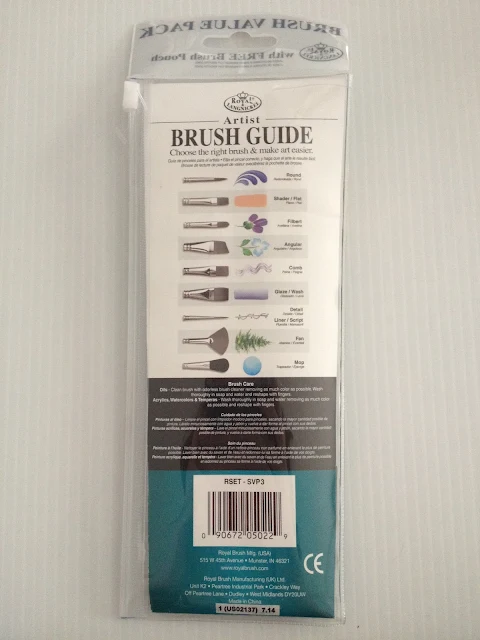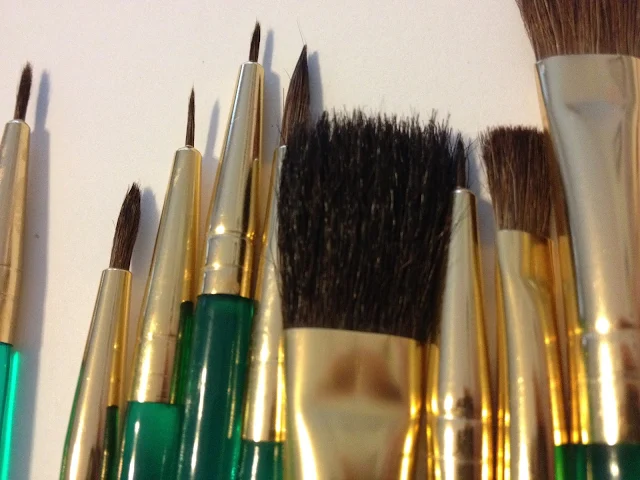Walmart Art Supply Review: Royal Langnickel Brush Value Pack
 |
| The Art Supply section of the Luling Walmart. Larger than it was when I was in undergrad, smaller than when I was in highschool. You aren't spoiled for selection here. |
For many, this is a sadly familiar sight- the third of an aisle dedicated to art supplies. Your options are as limited as your budget if you're shopping at Walmart for your art supplies, but I know this is it for many young artists, or artists on a budget. We've already covered two brands of watercolors sold at Walmart- Alex, Crayola watercolors, and Crayola markers, and I used Walmart-available brushes for both tests. If you haven't checked those reviews out, I highly recommend them, and if you're interested in the Royal Langnickel brushes I used, you should keep reading!
-
My Walmart, not surprisingly, didn't have a very large selection of brushes to choose from, and no open stock brushes, which may have been for the best. Most of the bristle brushes on sale were made by Royal Langnickel, a brand I don't currently use. You can see their selection of 'Good' brushes here, which is the section I assume the Walmart brush set falls into. This page fairly represents the selection of Royal Langnickel brushes that were available at my Luling Walmart. The site lists these brushes at $9.99, but I paid $7.97.
I opted to buy the only set that advertised as being for watercolor- a squirrel and camel blend with bright yellow ferrules and green plastic handles. The included card gave me an easy rundown of the deets:
- Comes with a Free Brush Pouch
- 10 Brushes total
- Sabel/Camel
- For Acrylics, Watercolors, Temperas, and Oils
- Features an Exclusive Edge
- Brushes include a flat-5/8", Shaders in 2, 6, 10, Rounds in 1, 3, 5, Detail Rounds in 3/10, 2/0, 0
- The back of the package recommends washing in soap and water, and reshaping with fingers, and I'm going to do just that before painting.
The Free Brush Pouch has me torn- I'm not really into the fact that it's a walking advertisement, but I LOVE when companies introduce reusable, sturdy packaging. I suppose you could just cut the top tag off, and it'd be just as good as any other pouch, so points to Royal Langnickel. The package has one of those little plastic ties to keep people from stealing brushes, but that's easy enough to snip, and this type of package generates very little waste, and means artists who are just starting out don't have to find storage solutions immediately.
The back of the package has a brush guide that explains what each type of brush is generally used for, as well as care tips, which is really handy if you're new to watercoloring and need a bit of a brush primer.
The Brushes
These brushes feature what Royal Langnickel touts as an 'exclusive edge'!. Usually you see this sort of edge on cheaper acrylic hog bristle brushes- it's used to scrape away paint or do sgraffito techniques.
It looks like the majority are made with squirrel hair, except for the mop (the largest brush), which is a bit coarser and may be camel, as the package promises squirrel and camel fibers. These brushes are intended to be used for Acrylics, Watercolors, Temperas, and Oils, but squirrel is a bit soft for acrylics.
Upon opening the package, I found the brushes somewhat hard to remove, as they'd all been taped together at the bottom. They also feel really cheap, which shouldn't be surprising, as I only paid $7.97 for all of them. The metal ferrule feels light and flimsy, the plastic bodies are green plastic with a slanted edge at the bottom, and also feel very light. The size of the brush and Royal Camel Hair are printed on the side in gold paint. Some of the brushes have plastic caps over the bristles, while others do not, but all of the brushes have glue to protect the bristles. So the first thing I'm going to have to do is wash the glue out.
Preparing Brushes for First Use
So I've promised you guys that I'd try and do more video work for the blog, and this rough video was one of my first attempts. I demonstrate how to prepare brushes for first use, using nothing but what was on hand in my mom's bathroom (I was visiting out of town).
I noted this in the video, but for any of you guys who opted to skip it (and there's no shame in admitting it, sometimes I skip videos too if I'm not in a good place to watch them), these brushes started shedding hairs as I washed them, even though I was using cold water. Not really a sign of great things to come. I shampooed and conditioned the fibers, and left them with conditioner in them overnight.
I used what we had available, but you can use baby shampoo and a cheap, unscented conditioner for a better result, or you can use actual brush soap. But if you have brush soap on hand, you probably don't need me to teach you how to prepare brushes, do you?
After Washing
The brushes are much, much softer, although the mop has very wavy fibers- must be the camel hair. While washing the brushes, I really noticed how badly balanced these brushes really are- the plastic body isn't heavy enough to compensate for the metal ferrule (as lightweight as it is- it must be aluminum, so maybe it won't rust or tarnish) and the hairs that make up the brushes themselves.
Unfortunately, as I'm leaving Luling on Saturday, I'm going to have to pack these babies up and test them when I return to Nashville, sometime after Saturday. I am packing these brushes without any protective agent to prevent the bristles from getting bent, but I could have left the dried, hardened conditioner in for shipping, and washed them in Nashville. At this point, if the bristles are bent when I resume this review, that's my fault. I will note that the 0 round is already bent, and I think I mentioned that it was bent in the video about washing and conditioning your brushes. With a little care, they pack into the pouch ok, and hopefully the stiff plastic will keep my brushes safe during their travels. With this sort of case, you have to let your brushes dry out completely, or they will mildew.
 |
| Brushes washed, dried, repacked, and labelled for shipping. |
The Field Test
 |
| I used a Royal Langnickel round for the swatches as well, as I wanted to see how well they performed at scrubbing and releasing pigments. |
Did the Daler Rowney Swatch Test with the 5 round. It's ok. A couple straggly hairs even after washing and conditioning, but not the absolute worst brush I've ever used. Definitely feels light and cheap in the hand after years of painting with wood handled brushes.
The 5 doesn't really ever pull a point, so you can't get any sort of detail with it, it mostly just pushes the paint around. It has no belly, so it just sort of slops the water right onto the paper.
The 2 round does a little bit better job of holding a point and pulling details, but it still fights me when it comes to details.
And here's the finished watercolor! Check the Daler Rowney Simply Watercolor Review to see what I thought of these paints!
I also used a combination of the Crayola brush with the Royal Langnickel Brush set for the Crayola test.
This is what they looked like after the Daler Rowney test. I didn't clean them in between, other than rinses in a cup of clean water. The yellow brush is the Crayola watercolor brush, included with the 8 piece Crayola children's watercolor set I purchased. The Crayola brush looks similar to the Royal Langnickel brushes, other than having a bump of plastic above the ferrule to keep it from wiggling out of place. I prefer the silver ferrule (probably aluminum) to the strangely yellow ferrules of the Royal Langnickel brushes.
I used the (I'm assuming) camel hair mop to apply a wash.
And knocked in background details with a smaller flat brush.
 |
| Left: Crayola Brush. Right: Royal Langnickel Size 2 Round |
And here's the finished Crayola test. Check the review to see what I thought of the 8 pack of Crayola washable watercolors!
The Verdict
These brushes handle like beaten up, mistreated Escodas or Series 7s. They COULD be decent, but there's just enough wrong with them that they would never be your first choice if you had better options available. Even with cleaning and conditioning, the brushes still just push paint around, which isn't really what you want with a good watercolor brush.
Although these brushes aren't the absolute worst (at least they don't shed hairs in my paint, YET), I recommend skipping these if you have better options in your area. Brushes are an investment that can last a long time if well taken care of, so there's no excuse to scrimp. If you don't have better options in your area, or you want a full kit from the get go (and plan to replace brushes as you go), these are an alright start. These would be fine for a beginner watercolorist, or a particularly adept child with an interest in watercolor.


















Comments
Post a Comment